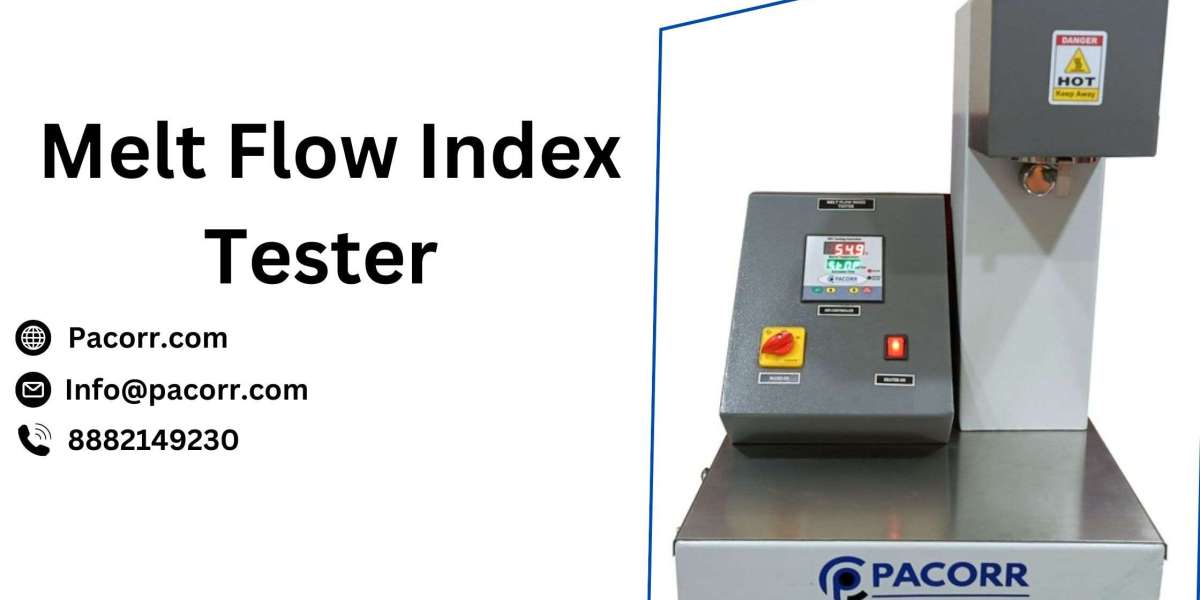What is a Melt Flow Index Tester?
The Melt Flow Index Tester, also known as a Melt Flow Rate (MFR) Tester, measures the rate of extrusion of a thermoplastic material through a die of specified dimensions under a prescribed temperature and pressure. The MFI value indicates the ease of flow of the melted material, which is a crucial factor in understanding the material's viscosity and processability.
Importance of Melt Flow Index Testing
- Quality Control: The Melt Flow Index Testing is a standard procedure in quality control to ensure that the polymer batch meets the specified criteria. Consistent MFI values imply uniformity in the polymer's molecular weight distribution, which translates to consistent product quality.
- Material Selection: Engineers and product designers use MFI values to select appropriate materials for specific applications. Different applications require different flow characteristics, and the MFI test helps in identifying the suitable material.
- Production Optimization: By understanding the flow properties of the polymer, manufacturers can optimize processing conditions such as temperature, pressure, and cooling rates to achieve the desired product characteristics efficiently.
- Compliance with Standards: Many industries have stringent standards for material properties. The MFI test ensures that the materials comply with international standards such as ASTM D1238 and ISO 1133, which are critical for global trade and regulatory compliance.
How Does the Melt Flow Index Tester Work?
The Melt Flow Index Tester Price operates by extruding a molten polymer through a die using a specified weight. Here are the basic steps involved in the testing process:
- Sample Preparation: A small amount of polymer is heated in a barrel to a specific temperature until it reaches a molten state.
- Extrusion: A defined weight is applied to the molten polymer, forcing it through a die with a standard diameter.
- Measurement: The extrudate is collected over a set period, usually 10 minutes. The mass of the extrudate is measured, and the melt flow rate is calculated in grams per 10 minutes (g/10 min).
Applications of Melt Flow Index Testing
- Injection Molding: In injection molding, the MFI value helps in determining the optimal processing parameters to produce defect-free parts with precise dimensions and mechanical properties.
- Blow Molding: For blow molding applications, such as the production of bottles and containers, the MFI value ensures that the material has the appropriate flow characteristics to form thin, uniform walls.
- Extrusion: In extrusion processes, where continuous profiles such as pipes and films are produced, the MFI test ensures that the polymer can be processed at the desired speed without compromising quality.
- Compounding: In the production of polymer compounds and masterbatches, the MFI test helps in adjusting formulations to achieve the required flow properties for downstream processing.
Choosing the Right Melt Flow Index Tester
When selecting a Melt Flow Teste, manufacturers should consider the following factors:
- Temperature Control: Accurate and stable temperature control is crucial for reliable MFI measurements. Look for testers with precise temperature regulation systems.
- Load Weights: The availability of various load weights allows for flexibility in testing different materials under various conditions.
- Ease of Use: User-friendly interfaces and automated features enhance the efficiency of the testing process, reducing the potential for human error.
- Compliance with Standards: Ensure that the tester complies with relevant international standards to guarantee the accuracy and reliability of the test results.
Conclusion
The Melt Flow Index Tester is an indispensable tool in the plastics industry, providing vital data that underpins quality control, material selection, and production optimization. By understanding the flow properties of polymers, manufacturers can ensure consistent product quality, meet industry standards, and optimize manufacturing processes. Investing in a reliable Melt Flow Index Tester is a strategic decision that can significantly enhance the efficiency and competitiveness of plastics manufacturing operations.
FAQ Section
Q1: What is the Melt Flow Index?
A1: The Melt Flow Index (MFI) is a measure of the rate of extrusion of a thermoplastic polymer through a die under specified temperature and pressure conditions. It indicates the ease of flow of the melted material.
Q2: Why is the Melt Flow Index important?
A2: The Melt Flow Index Tester is crucial for quality control, material selection, production optimization, and compliance with industry standards. It helps ensure consistent product quality and efficient manufacturing processes.
Q3: How is the Melt Flow Index measured?
A3: The MFI is measured by heating a polymer sample to a molten state, applying a specified weight to extrude the polymer through a die, and measuring the mass of the extrudate over a set period. The result is expressed in grams per 10 minutes (g/10 min).
Q4: What industries use Melt Flow Index testing?
A4: Industries such as plastics manufacturing, injection molding, blow molding, extrusion, and polymer compounding use MFI testing to ensure the quality and processability of their materials.
Q5: How does the MFI value affect material selection?
A5: The Melt Flow Index Testing value helps engineers and designers choose materials with appropriate flow characteristics for specific applications, ensuring optimal performance and quality of the final product.
Q6: What standards govern Melt Flow Index testing?
A6: Common standards for MFI testing include ASTM D1238 and ISO 1133, which specify the methods and conditions for conducting the test.
Q7: Can the Melt Flow Index Tester be used for all types of polymers?
A7: While the MFI test is applicable to a wide range of thermoplastic polymers, it is essential to ensure that the tester is suitable for the specific material and testing conditions required.
Q8: What features should be considered when choosing a Melt Flow Index Tester?
A8: Key features to consider include precise temperature control, availability of various load weights, ease of use, and compliance with international standards.
For more information on the Melt Flow Index Tester and how it can benefit your manufacturing process, visit Pacorr Testing Instruments.








